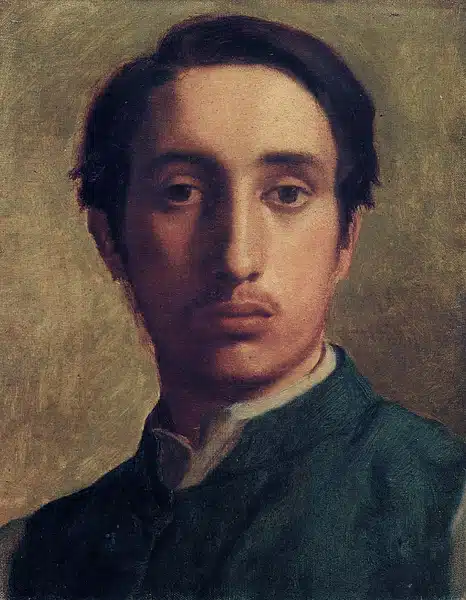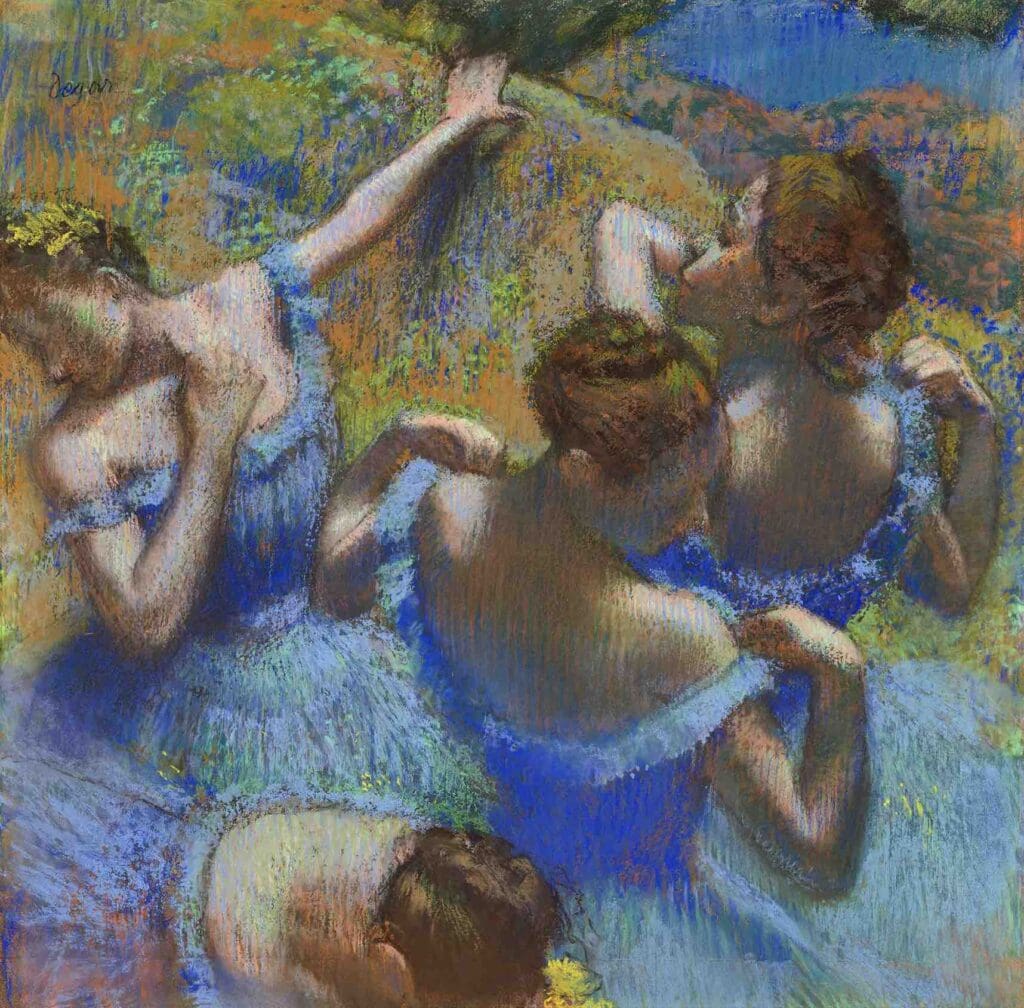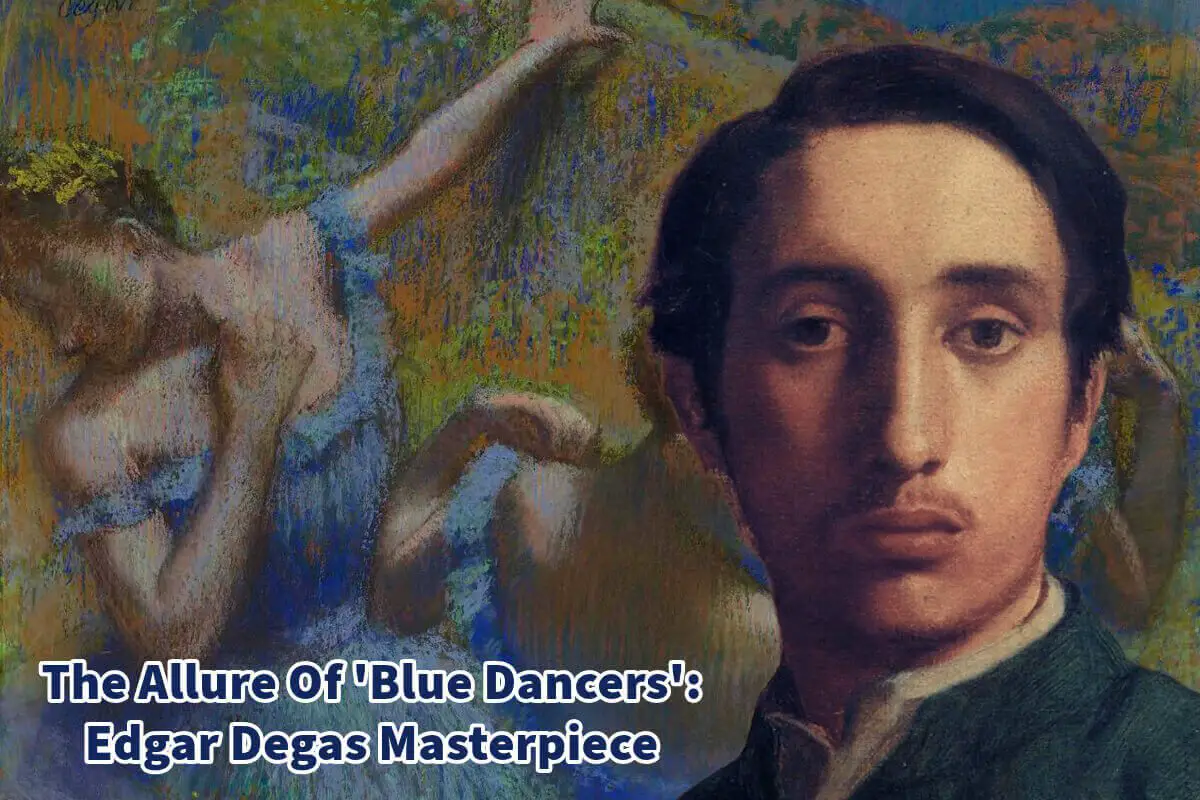Considered one of the greatest painters in history, Edgar Degas is undoubtedly a towering figure in the art world. It’s no surprise that his portfolio boasts numerous iconic works.
One of Edgar Degas’s most mesmerizing paintings is the ‘Blue Dancers.’ This piece captures Degas at his finest, focusing on a subject that he was particularly passionate about dancers. Continue reading as we delve into the captivating universe of Edgar Degas and explore why ‘Blue Dancers’ is one of his most significant masterpieces.
Table of Contents
- The Allure Of ‘Blue Dancers’: A Deep Dive Into Edgar Degas And His Masterpiece
- Who Is Edgar Degas?
- Why ‘Blue Dancers’ Is An Important Work
- Frequently Asked Questions
- Related Questions
The Allure Of ‘Blue Dancers’: A Deep Dive Into Edgar Degas And His Masterpiece
Artists like Monet and Renoir often come to mind when one thinks of Impressionism. However, no discussion of this pivotal art movement would be complete without Edgar Degas.
Edgar Degas was a man of profound complexity and talent; Degass redefined the conventions of 19th-century art, breathing life into ordinary and extraordinary subjects.
Among his most mesmerizing works is the painting ‘Blue Dancers.’ A kaleidoscope of color and emotion, this masterpiece encapsulates the ingenuity and brilliance of Degas. Let’s dive deep into the world of Edgar Degas and explore why ‘Blue Dancers’ stands as a beacon of his artistic prowess.
Who Is Edgar Degas?
Born Hilaire-Germain-Edgar De Gas in 1834, Edgar Degas was a French artist known primarily for his intricate depictions of ballet dancers and his explorations of various other aspects of Parisian modern life.

Despite his association with the Impressionist movement, Degas preferred the term ‘realist,’ focusing on the human form and its complexities.
He was born into a modestly wealthy family, which allowed him the freedom to travel and study art extensively. He started his formal training under Louis Lamothe, a pupil of the famed Ingres, and briefly attended the prestigious École des Beaux-Arts.
However, his independent research, including multiple trips to Italy to study the great works of Renaissance artists, shaped his unique approach to art.
Why Is Edgar Degas An Important Artist?
There are many reasons why Edgar Degar is considered to be one of the most influential artists ever to live.
Edgar Degas brought a fresh perspective to the art of his time in several ways. Below are some of the ways he brought a fresh perspective to art.
Technical Brilliance
Degas was a virtuoso in various mediums, including oils, pastels, and sculpture. His technical skills were impeccable, evident in his mastery of anatomy, perspective, and color.
Psychological Depth
Many of his works, especially his portraits, offer deep psychological insights. Degas had a unique ability to capture the nuances of human emotion, giving his art a timeless quality.
Breaking Conventions
While trained in the academic style, Degas broke away from these traditional forms, innovating with composition, lighting, and subject matter.
Versatility
Although best known for his ballet scenes, Degas also painted portraits of historical scenes and even dabbled in printmaking and photography. This versatility adds layers of complexity to his oeuvre.
Why ‘Blue Dancers’ Is An Important Work

Created in the latter part of Degas’ career, around 1899, ‘Blue Dancers’ is a pastel artwork that showcases many of his signature traits—vivid coloring, dynamic composition, and emotional depth.
Here are some reasons why The Blue Dancers is considered an iconic work of art.
A Dance Of Colors
The immediate allure of the ‘Blue Dancers’ lies in its incredible use of color. Degas has applied multiple shades of blue with astonishing skill, creating a rich tapestry of hues that define the dancers and set the emotional tone for the entire piece.
Blue, traditionally associated with tranquility and depth, here takes on an electric quality, capturing the vibrancy and intensity of the performance.
Composition And Form
The dancers are positioned in various stages of movement, with a fluidity that offers a snapshot of the dance in progress. Degas’ use of perspective here is groundbreaking. The viewers feel as if they are part of the audience, yet also gain an intimate backstage view, a vantage point that was a hallmark of many of Degas’ works.
Emotional Complexity
Beyond the spectacle, Degas imbues the painting with emotional depth. The dancers are not merely decorative figures; their postures and expressions invite us to ponder their experiences and emotions.
Are they anxious, excited, tired? Degas leaves this intentionally ambiguous, allowing the viewer to interact with the artwork on a profoundly personal level.
Contextual Relevance
‘Blue Dancers’ fits into the broader context of Degas’ lifelong fascination with ballet and dancers. It’s an evolution of his earlier works, capturing the culmination of his artistic maturity.
Compared to his earlier ballet pieces, one can see a shift in technique and the emotional nuance presented. This painting offers us a glimpse into the mind of an artist at the height of his powers, unafraid to experiment and push boundaries.
Edgar Degas was not just a painter but a visionary who redefined what art could achieve. He captured the complexities of human emotion, the subtleties of light and shadow, and the fluidity of movement like few others could. ‘Blue Dancers’ is an iconic testament to Degas’ extraordinary skill and creative vision.
Through its mesmerizing color palette, intricate composition, and emotional complexity, the painting invites us to appreciate the aesthetic beauty on display and dive into a world of more profound meaning and interpretation.
As we stand before ‘Blue Dancers,’ we are reminded why Edgar Degas remains an indelible part of art history—a master of form and emotion whose work continues to inspire, challenge, and captivate.
Anita Louise Art is dedicated to art education, great artists, and inspiring others to find and create their art. We love art that uplifts and inspires. #ArtToMakeYouSmile! #ArtToMakeYouHappy!
If you are interested to see any of my art, you can find out more by clicking here. If you are interested in what inspires me and my paintings, you can discover more by clicking here.
We have a free newsletter and would love you to be part of our community; you can subscribe to the newsletter by clicking here. If you have any questions, I would be happy to talk to you any time. You can reach me, Anita, by clicking here.
Subscribe to our Anita Louise Art YouTube Channel filled with great videos and information by clicking here.
Join us for our podcast “5 Minutes With Art.” Spend 5 minutes a week with us to discover and learn about great art and artists. You can find out more about our podcast by clicking here.
Frequently Asked Questions
What is the significance of Edgar Degas in art history, and why is he considered one of the greatest painters?
Edgar Degas is celebrated as one of the greatest painters in history. His contributions to art, particularly in the realm of Impressionism, have left an indelible mark. Learn more about his impact on the art world.
Can you provide a brief overview of Edgar Degas’s artistic style and thematic focus?
Understanding Degas’s artistic style is essential to appreciating his masterpieces. Explore the distinctive elements that characterize his work and the recurring themes that captured his imagination.
What is ‘Blue Dancers,’ and why is it considered one of Edgar Degas’s most mesmerizing paintings?
Delve into the details of ‘Blue Dancers,’ examining why this particular artwork is hailed as one of Degas’s masterpieces. Explore the elements that make it stand out among his extensive body of work.
Why was Edgar Degas particularly passionate about depicting dancers in his art?
Learn about Degas’s fascination with dancers and the significance of this theme in his artistic expression. Uncover the motivations behind his focus on capturing the world of dance.
What are the key artistic techniques and innovations employed by Edgar Degas in ‘Blue Dancers’?
Analyze the artistic techniques and innovations Degas utilized in creating ‘Blue Dancers.’ Understand how these contribute to the overall impact and allure of the masterpiece.
How does ‘Blue Dancers’ exemplify the principles of Impressionism, a movement to which Degas belonged?
Explore the connection between ‘Blue Dancers’ and the Impressionist movement. Understand how Degas incorporated Impressionist principles into this particular painting.
Are there any hidden meanings or symbolism in ‘Blue Dancers’ that viewers may not immediately recognize?
Art often carries hidden meanings. Investigate whether ‘Blue Dancers’ holds any hidden symbolism or deeper layers of interpretation that might not be immediately apparent to viewers.
Can you provide insights into the critical reception of ‘Blue Dancers’ during Edgar Degas’s time?
Understand how ‘Blue Dancers’ was received by critics and the art community during Edgar Degas’s era. Explore the initial reactions and reviews that shaped the painting’s early reception.
How has the legacy of ‘Blue Dancers’ endured over time, and what impact has it had on the art world?
Examine the lasting legacy of ‘Blue Dancers’ and its ongoing impact on the art world. Discover how this masterpiece has continued to influence artists and art enthusiasts through the years.
Where can one view ‘Blue Dancers’ today, and what efforts have been made to preserve and showcase this Edgar Degas masterpiece?
Find out where ‘Blue Dancers’ is currently located and learn about the efforts made to preserve and showcase this iconic Edgar Degas painting. Explore the avenues through which art enthusiasts can experience the allure of ‘Blue Dancers’ today.
Related Questions
What Was The Impact Of Vincent Van Gogh On The Art World?
Van Gogh used color, form, and emotions in his art. He had a bright palette that was individualized for his time. Even though he did not see a lot of success during his life after he died, the impact of his art can be seen in both the Expressionism and Fauvism movements that were taking place in Europe.
By clicking here, you can learn more by reading What Was The Impact Of Vincent Van Gogh On The Art World?
Similarities Of Claude Debussy And Claude Monet
Claude Debussy and Claude Monet are both artists, but one is a musical composer, and the other is an artist. They are both considered Impressionists, and they were not afraid to break from the tradition of their day to create something new. Their work was considered to be a bold change for the days.
You can discover more by reading Similarities Of Claude Debussy And Claude Monet by clicking here.
Neoclassicism: A Harmonious Revival Of Ancient Art
Neoclassicism, or Classicism, emerged as a significant artistic movement in the 18th century in response to the ornate and frivolous Rococo style. It drew inspiration from the art and culture of ancient Greece and Rome, emphasizing simple linear design and archaeologically accurate depictions of Classical themes. With its focus on harmony, clarity, restraint, universality, and idealism, Neoclassicism left an indelible mark on the visual arts.
You can learn more by reading Neoclassicism: A Harmonious Revival Of Ancient Art by clicking here.


